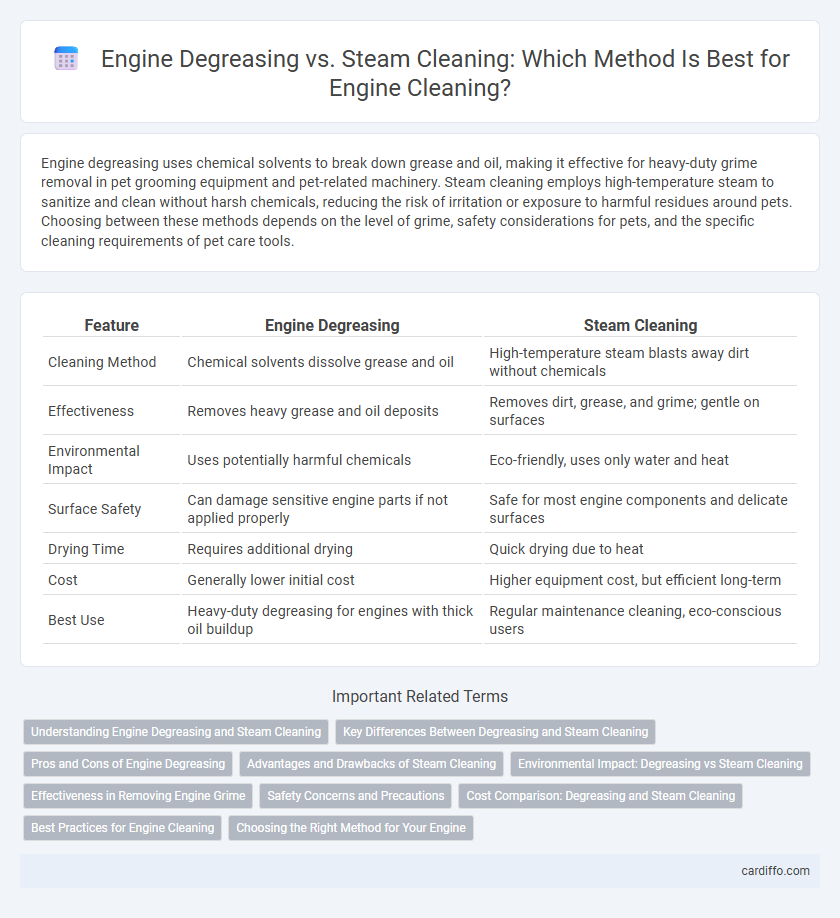Engine degreasing uses chemical solvents to break down grease and oil, making it effective for heavy-duty grime removal in pet grooming equipment and pet-related machinery. Steam cleaning employs high-temperature steam to sanitize and clean without harsh chemicals, reducing the risk of irritation or exposure to harmful residues around pets. Choosing between these methods depends on the level of grime, safety considerations for pets, and the specific cleaning requirements of pet care tools.
Table of Comparison
| Feature | Engine Degreasing | Steam Cleaning |
|---|---|---|
| Cleaning Method | Chemical solvents dissolve grease and oil | High-temperature steam blasts away dirt without chemicals |
| Effectiveness | Removes heavy grease and oil deposits | Removes dirt, grease, and grime; gentle on surfaces |
| Environmental Impact | Uses potentially harmful chemicals | Eco-friendly, uses only water and heat |
| Surface Safety | Can damage sensitive engine parts if not applied properly | Safe for most engine components and delicate surfaces |
| Drying Time | Requires additional drying | Quick drying due to heat |
| Cost | Generally lower initial cost | Higher equipment cost, but efficient long-term |
| Best Use | Heavy-duty degreasing for engines with thick oil buildup | Regular maintenance cleaning, eco-conscious users |
Understanding Engine Degreasing and Steam Cleaning
Engine degreasing involves applying specialized solvents to dissolve and remove heavy oil, grease, and grime from engine surfaces, ensuring deep cleaning of hard-to-reach areas. Steam cleaning uses high-temperature steam to lift dirt and contaminants without harsh chemicals, offering an eco-friendly solution that also disinfects engine components. Understanding their differences helps in selecting the most effective method for specific engine types and maintenance needs.
Key Differences Between Degreasing and Steam Cleaning
Engine degreasing uses chemical solvents to break down heavy grease and oil, providing a thorough cleaning by dissolving contaminants on engine surfaces. Steam cleaning relies on high-temperature steam to loosen dirt and grime, offering a more environmentally friendly method that avoids harsh chemicals. The key differences lie in the cleaning agents used, effectiveness on tough grease, and environmental impact, with degreasing excelling in heavy residue removal and steam cleaning favored for eco-conscious maintenance.
Pros and Cons of Engine Degreasing
Engine degreasing effectively removes heavy grease and oil buildup using strong solvents, making it ideal for deeply soiled engines. However, the chemicals used can be harsh, potentially damaging sensitive engine components and requiring careful handling and disposal. Compared to steam cleaning, degreasing offers faster results but poses greater environmental and safety risks.
Advantages and Drawbacks of Steam Cleaning
Steam cleaning offers the advantage of using high-temperature steam to effectively break down and remove grease and grime without harsh chemicals, making it an eco-friendly method for engine degreasing. Its ability to sanitize surfaces by killing bacteria and reducing hazardous waste highlights its environmental benefits. However, drawbacks include the potential risk of moisture damage to sensitive engine components and longer drying times compared to traditional degreasers.
Environmental Impact: Degreasing vs Steam Cleaning
Engine degreasing typically involves chemical solvents that can release volatile organic compounds (VOCs) and hazardous waste, posing significant environmental risks if not disposed of properly. Steam cleaning uses high-temperature steam to break down grease and dirt, reducing the need for harmful chemicals and minimizing water usage while producing fewer pollutants. Choosing steam cleaning over degreasing offers a more eco-friendly alternative with lower toxic emissions and less environmental contamination.
Effectiveness in Removing Engine Grime
Engine degreasing specifically targets heavy oil, grease, and stubborn grime using potent chemical sprays designed to break down contaminants effectively. Steam cleaning uses high-temperature steam to loosen and lift dirt and grease while minimizing the need for harsh chemicals, making it effective for delicate engine parts. Both methods significantly enhance engine cleanliness, but degreasing often achieves deeper grime removal in heavily soiled engines.
Safety Concerns and Precautions
Engine degreasing involves the use of chemical solvents that can emit harmful fumes and cause skin irritation, necessitating the use of gloves, eye protection, and adequate ventilation. Steam cleaning eliminates the need for harsh chemicals but requires careful temperature control to prevent burns and avoid damaging sensitive engine components. Both methods demand proper safety protocols to protect the user and maintain the engine's integrity during the cleaning process.
Cost Comparison: Degreasing and Steam Cleaning
Engine degreasing typically costs between $50 to $100 per session, making it a budget-friendly option for removing grease and grime from engine components. Steam cleaning, while more effective at eliminating stubborn dirt and reaching tight spaces, often ranges from $100 to $200 depending on the service provider and equipment used. Choosing between degreasing and steam cleaning depends on budget constraints and the desired level of cleaning precision, with degreasing offering affordability and steam cleaning providing thoroughness.
Best Practices for Engine Cleaning
Engine degreasing involves applying specialized solvents to break down grease and oil deposits, ensuring thorough removal of contaminants without damaging sensitive components. Steam cleaning uses high-temperature vapor to loosen dirt and grime, offering an eco-friendly alternative that minimizes chemical use and reduces water consumption. Best practices for engine cleaning combine careful selection of degreasers, controlled steam application, and protective measures for electrical parts to achieve optimal results while maintaining engine integrity.
Choosing the Right Method for Your Engine
Engine degreasing uses chemical solvents to break down grease and oil, providing deep cleaning for heavily soiled engines. Steam cleaning employs high-temperature steam to remove dirt and grime without harsh chemicals, minimizing environmental impact and reducing corrosion risk. Selecting the right method depends on the engine's condition, sensitivity to chemicals, and environmental considerations.
Engine Degreasing vs Steam Cleaning Infographic

 cardiffo.com
cardiffo.com